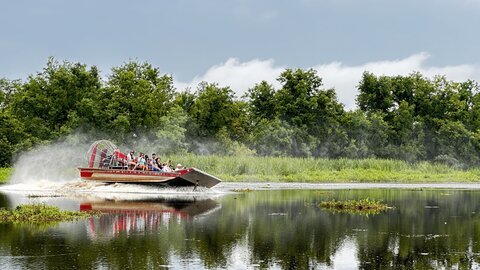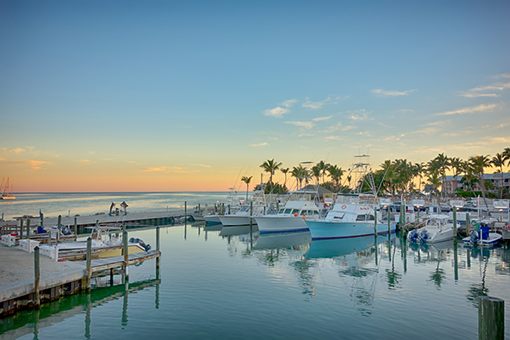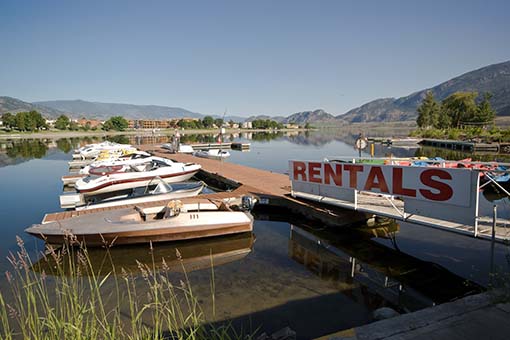An airboat resembles a giant fan attached to the back of a flat boat. That's basically what it is, and it works incredibly well for navigating shallow water where traditional vessels would get stuck in seconds.
If you've never seen one in person, airboats are those loud, flat-bottomed vessels with massive propellers mounted on the back. They're also called fan boats or swamp boats, and they're purpose-built for getting through water that would stop pretty much any other watercraft.
How Do Airboats Work?
An airboat is powered by an aircraft propeller mounted above the deck. Instead of using underwater propulsion like regular boats, they push air backward to create forward thrust. Think of it like a desk fan pushing you forward instead of a motor spinning an underwater prop.
The design is simple but effective! The hull sits almost completely flat on the water with minimal draft. And the propeller — either driven by automotive engines or actual aircraft engines — pushes massive amounts of air backward. This creates thrust that moves the boat forward across water, mud, grass, or any other wet surface, thereby reducing friction.
Most modern airboats use automotive engines because they're cheaper and easier to maintain than aircraft engines. The engine sits on an elevated platform behind the passenger area, connected to the propeller through a reduction drive. Steering works through rudders mounted in the propeller wash, which means you turn by redirecting the airflow.
How are Airboats Different from Other Vessels?
Airboats dominate in shallow water environments where traditional boats are ineffective. The Florida Everglades made airboats famous, but they're used throughout the United States! Essentially, anywhere shallow water and heavy vegetation create problems for regular boats.
Swamps, marshes, and floodplains are perfect airboat territory. They can operate in water just inches deep and push through grass, lily pads, and light vegetation that would stop a regular propeller instantly. This makes them ideal for accessing remote areas that boats with underwater props can't reach.
Law enforcement and search-and-rescue operations rely on airboats for exactly this reason. When flooding happens or someone needs rescuing, airboats can go places helicopters can't land and traditional boats can't navigate.
Read Next: How to Plan a Boating Vacation
Common Uses for Airboats
Airboat tours have become a huge business in destinations like the Florida Everglades. Tour operators use them to give visitors access to wildlife and scenery that's otherwise impossible to reach. You can get within viewing distance of alligators, wading birds, and other swamp wildlife without disturbing their habitat.
Fishing guides use airboats to access remote fishing spots in shallow marshes and backwaters. Accessing shallow-water species like bass, redfish, and others that hide in vegetation is possible with these kinds of vessels!
Additionally, hunters appreciate airboats for accessing duck marshes and other areas that four-wheelers can't reach. The ability to cross mud, shallow water, and thick vegetation opens up territory that remains uninhabited by other hunters.
What to Expect on Airboat Rides
First-time airboat riders are always surprised by two things: the speed and the noise!
Modern airboats can reach speeds of 50-60 mph across flat water. That's fast enough that most operators require passengers to wear hearing protection and life jackets. And the wind in your face at those speeds gets intense!
Additionally, the noise level is serious. That big propeller spinning at high RPM creates sound levels that require hearing protection for anyone aboard. Tour operators provide headsets or earplugs, and you should absolutely use them!
The ride itself also feels different from that of regular boats. Airboats sit on top of the water rather than cutting through it. (You feel every ripple and wake more directly.) Most tours last 30-60 minutes and cover several miles of waterways!
History of Airboats
Aviation pioneers developed the first airboat prototype in the early 1900s to navigate shallow swamps. Legend has it that Alexander Graham Bell built one of the earliest versions in 1905, though it wasn't until the 1930s that Floridians really caught on.
The basic design — flat bottom with a giant fan strapped to the back — hasn't changed much because honestly, why mess with perfection? Modern models swap wooden hulls for aluminum and fiberglass, making them lighter, faster, and way more reliable than those early swamp boats.
Safety Considerations
Before your tour, follow these crucial safety tips:
- Never stand up or move around while the boats are running.
- Always keep your hands and arms inside the boat. A cage protects the propeller, but the airflow can still catch loose items.
- Hearing protection isn't optional—it's necessary. Extended exposure to airboat noise levels causes permanent hearing damage.
- Life jackets should be worn by everyone aboard. The flat bottom makes airboats stable, but capsizing is still possible, especially at high speeds or in rough turns. Plus, many airboats operate in remote areas where help takes time to arrive.
Lastly, respect wildlife viewing distances. Just because these boats can get close to wildlife doesn't mean they should!
Should You Go on an Airboat Ride?
If you enjoy wildlife or want to see ecosystems that regular boats can't reach, airboat tours are worth trying! They aren't for everyone—the noise and speed can be overwhelming. But if you're comfortable in loud environments and want to explore shallow-water areas, they offer access that nothing else can match!
We hope this guide answered your questions, so you can decide if airboat rides are right for your next adventure!


